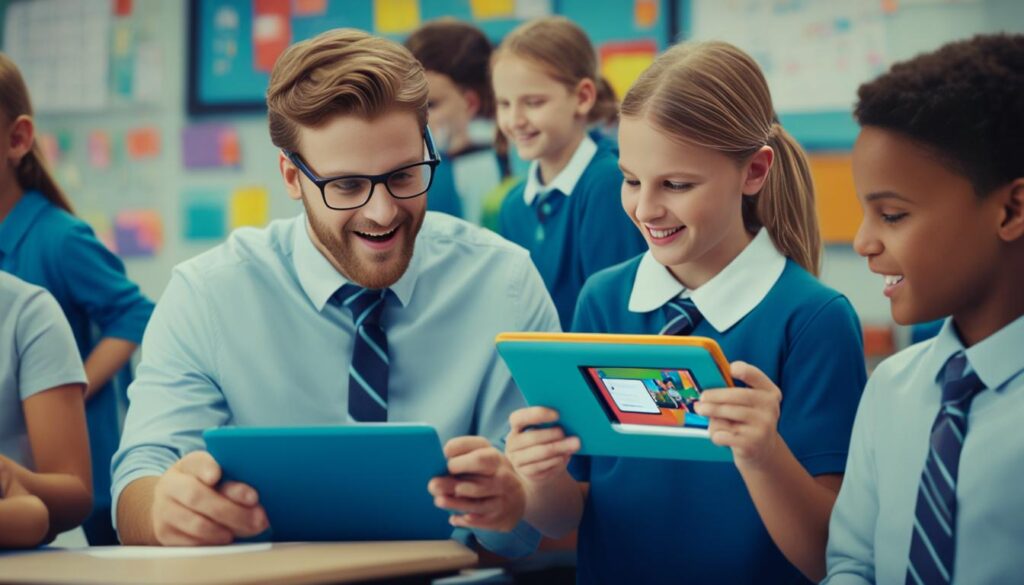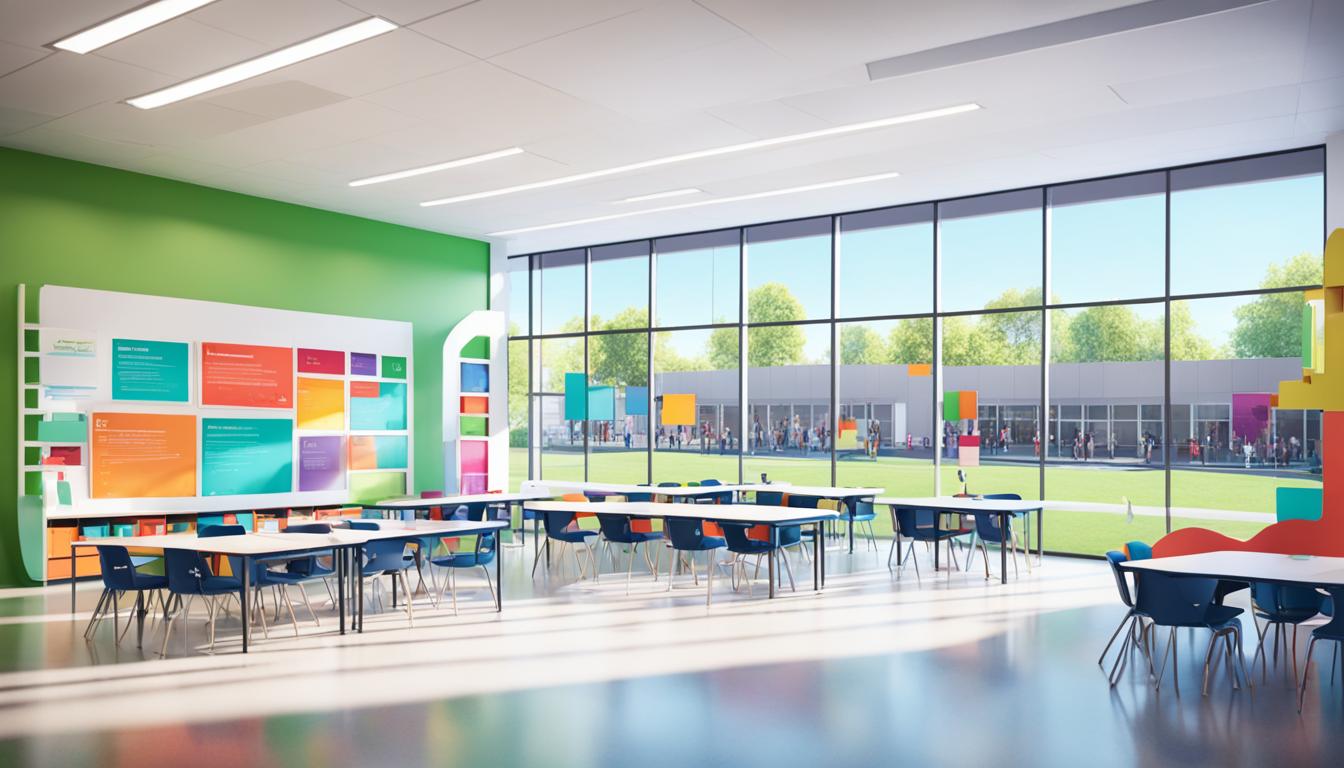Are traditional educational models still effective in today’s rapidly evolving world? Do they truly prepare students for the future? These questions have become increasingly relevant as we recognize the need for innovative approaches to education that align with the demands of the 21st century.
At Canada Global Academy’s School Partnership Program, pioneering school model innovations are transforming the educational landscape, challenging traditional norms, and revolutionizing the way we teach and learn. Through this program, schools have access to a wealth of resources, training, and support to implement cutting-edge educational practices that have a lasting impact on student academic and personal growth.
But what are these pioneering school model innovations, and what is their impact on students and schools? In this article, we will explore the groundbreaking approaches, technologies, and frameworks that are reshaping traditional learning environments. We’ll delve into the benefits of student-centered approaches, personalized instruction, and project-based learning. We’ll also uncover how schools are prioritizing student well-being, supporting mental health education, and developing essential transferable skills.
Join us on this journey of discovery as we examine the impact of pioneering school model innovations on student learning outcomes and overall school effectiveness. Get ready to challenge your beliefs about traditional education and explore the possibilities of a future-focused educational landscape.
Contents
- 1 Pioneering School Model Innovations and Impact
- 2 Supporting Student Wellbeing Through Mental Health Education
- 3 Empowering Learners to Manage Screen Time
- 4 Readying Ontario Students with Transferable Skills for Life
- 5 Aligning Career Education with Employability Skills
- 6 Applying Entrepreneurial Thinking Across Subjects
- 7 Embedding Core Competencies Into Classrooms
- 8 Championing Digital Citizenship & Literacy in Schools
- 9 Promoting Global Citizenship and Diversity
- 10 Fostering Creativity and Innovation Skills
- 11 FAQ
- 11.1 How are pioneering school model innovations impacting student learning outcomes?
- 11.2 What is the Canada Global Academy’s School Partnership Program?
- 11.3 How does the micro-school partnership program at Rosedale High School work?
- 11.4 How do pioneering school models prioritize student well-being through mental health education?
- 11.5 How do schools balance digital learning and overall well-being?
- 11.6 How do schools prepare students with transferable skills for life?
- 11.7 How do schools align career education with employability skills?
- 11.8 How do pioneering school models foster entrepreneurial thinking?
- 11.9 How do schools embed core competencies into classrooms?
- 11.10 How do schools promote responsible digital engagement?
- 11.11 How do pioneering school models promote global citizenship and diversity?
- 11.12 How do schools foster creativity and innovation skills?
- 12 Source Links
Key Takeaways:
- Explore how pioneering school models are revolutionizing education.
- Discover the benefits of student-centered approaches and personalized instruction.
- Uncover the impact of mental health education on student well-being.
- Learn about the development of transferable skills for life.
- Understand the importance of aligning career education with employability skills.
Pioneering School Model Innovations and Impact
Explore how Canada Global Academy’s School Partnership Program is revolutionizing schools. Visit canadaglobalacademy.com/school-partnership-program/ to learn more.
Innovative Learning Environments
Pioneering school model innovations are reshaping traditional learning environments. These models prioritize student-centered approaches, project-based learning, and personalized instruction to cater to individual student needs and interests.
One example is the micro-school partnership program developed by Ethos Education and implemented at Rosedale High School. This program creates small, close-knit learning communities where students receive personalized attention and support.
Through this model, students have access to innovative learning resources, individualized instruction, and real-world learning experiences. Educational impact assessments have shown that these types of innovative learning environments lead to improved student engagement, academic achievement, and overall well-being.
Supporting Student Wellbeing Through Mental Health Education

Pioneering school models recognize the importance of supporting student wellbeing through mental health education. Schools are prioritizing holistic approaches that address students’ physical, social, emotional, and mental needs. By incorporating mental health education into the curriculum, schools create a supportive and inclusive learning environment that promotes the overall wellbeing of students.
The Ontario Ministry of Education curriculum plays a vital role in emphasizing the integration of mental health education across all subjects. This comprehensive approach ensures that students have access to the necessary knowledge and resources to understand and manage their mental health effectively. It also helps reduce the stigma surrounding mental health issues and promotes a culture of mental health awareness and support within the school community.
Private schools in Ontario also play a significant role in student wellbeing. They provide additional comprehensive mental health support and resources to students, ensuring they have the tools to navigate challenges and thrive academically and personally. With smaller class sizes and a focus on personalized attention, private schools create an environment where students feel supported and valued.
“Supporting student wellbeing is not just about addressing academic needs; it encompasses their physical, emotional, and social wellbeing as well. By prioritizing mental health education, schools empower students to develop resilience, self-awareness, and healthy coping strategies, setting them up for success both inside and outside the classroom.” – Jane Thompson, Principal of Cedar Hill High School
Holistic Approaches to Student Wellbeing
One key aspect of supporting student wellbeing is adopting holistic education approaches. These approaches focus on nurturing the whole student, considering their physical, social, emotional, and mental needs. Holistic education recognizes that a student’s wellbeing is influenced by various factors, including their relationships, environment, and overall sense of purpose.
Through holistic education, schools aim to create a positive and nurturing learning environment where students feel supported and empowered. This includes implementing strategies such as:
- Providing access to mental health professionals and counselors who can offer guidance and support
- Incorporating mindfulness and stress reduction techniques into the daily routine
- Fostering strong relationships and a sense of belonging within the school community
- Promoting healthy lifestyle habits, including physical activity and balanced nutrition
By adopting these holistic approaches, schools foster an environment where students can thrive academically and personally, laying the foundation for lifelong wellbeing.
Explore how Canada Global Academy’s School Partnership Program is revolutionizing schools. Visit https://canadaglobalacademy.com/school-partnership-program/ to learn more.
Empowering Learners to Manage Screen Time
In the era of digital learning platforms and online education, it’s crucial for schools to empower learners with effective screen time management skills. Balancing digital learning with physical activity, face-to-face interactions, and overall well-being is paramount. Canada Global Academy’s School Partnership Program is leading the way in revolutionizing schools nationwide.
Schools are implementing policies and providing resources to help students develop healthy screen time habits. By incorporating regular breaks, promoting outdoor activities, and encouraging offline social interactions, students can maintain a balanced approach to education that supports their learning and overall well-being.
As illustrated by the image below, finding the right balance between screen time and in-person activities is essential for student success.
Balancing Digital Learning and Wellbeing
Empowering learners to manage screen time effectively goes beyond setting limits—it involves creating a holistic approach to education that promotes well-being. By striking a balance between digital learning and in-person experiences, schools can ensure that students thrive academically, socially, and emotionally.
Canada Global Academy’s School Partnership Program is transforming the educational landscape, providing schools with the resources they need to foster a healthy and balanced learning environment.
| Benefits of Balancing Screen Time | Importance of In-person Learning |
|---|---|
|
|
By empowering learners to manage their screen time effectively and striking a balance between digital learning and in-person experiences, schools can create a well-rounded educational environment that prioritizes student well-being and prepares them for success in the digital age.
Experience the transformative impact of Canada Global Academy’s School Partnership Program by visiting their website at https://canadaglobalacademy.com/school-partnership-program/.
Readying Ontario Students with Transferable Skills for Life

Pioneering school models in Ontario are committed to preparing students with transferable skills that will empower them throughout their lives. These skills go beyond traditional academic knowledge and focus on developing critical competencies that students can apply in various contexts and industries. By emphasizing the acquisition of transferable skills, schools aim to equip students with the tools they need to succeed academically, professionally, and personally in a rapidly changing world.
Developing Essential Transferable Skills
Transferable skills are those that can be applied across different subjects, careers, and life situations. Schools in Ontario prioritize the development of essential transferable skills that are aligned with the Ontario Ministry of Education standards. These skills include:
- Critical thinking: The ability to analyze information, evaluate arguments, and make informed decisions.
- Problem-solving: The capacity to identify and address challenges using logical and creative thinking.
- Communication: The skill to effectively convey ideas and collaborate with others.
- Collaboration: The ability to work well with others, share responsibilities, and achieve common goals.
- Adaptability: The capacity to adjust to new situations, learn from experiences, and embrace change.
Through a comprehensive curriculum and innovative teaching methods, schools in Ontario provide opportunities for students to develop these transferable skills from an early age. They incorporate interactive learning activities, real-world projects, and collaborative assignments that foster critical thinking, problem-solving abilities, effective communication, collaboration skills, and adaptability.
By embedding the development of these skills into the educational journey, schools aim to prepare students for success in K-12 education and beyond. These transferable skills are essential for future academic pursuits, professional careers, and personal growth.
| Transferable Skill | Description |
|---|---|
| Critical Thinking | The ability to analyze information, evaluate arguments, and make informed decisions. |
| Problem-Solving | The capacity to identify and address challenges using logical and creative thinking. |
| Communication | The skill to effectively convey ideas and collaborate with others. |
| Collaboration | The ability to work well with others, share responsibilities, and achieve common goals. |
| Adaptability | The capacity to adjust to new situations, learn from experiences, and embrace change. |
By nurturing the development of transferable skills, schools in Ontario ensure that students are well-equipped to excel in the dynamic and interconnected world they will enter after completing their education. These skills not only enhance academic performance but also contribute to personal development, career readiness, and lifelong learning.
Aligning Career Education with Employability Skills

Pioneering school models recognize the importance of aligning career education with the development of employability skills. By integrating career education into the curriculum, schools equip students with the knowledge, skills, and competencies needed to thrive in their chosen careers. This forward-thinking approach helps students understand the relevance of their education to real-world applications and prepares them for future success.
Through career education programs, students have the opportunity to explore various career pathways, gain practical experience through internships and apprenticeships, and develop the transferable skills that employers value. These programs provide a comprehensive framework for students to acquire employability skills such as critical thinking, problem-solving, communication, collaboration, and adaptability.
One example of a school that aligns career education with employability skills is the Canada Global Academy. Their School Partnership Program offers a unique approach to preparing students for the workforce by providing resources, training, and support for schools to implement innovative educational practices. Through partnerships with global university pathways and vocational training programs, students have access to diverse learning opportunities that enhance their employability.
By integrating career education into the curriculum, schools create a holistic learning experience that goes beyond academic knowledge, empowering students to become future-ready professionals. Through immersive learning experiences and exposure to real-world scenarios, students develop the practical skills and industry awareness necessary to navigate the rapidly changing job market.
By aligning career education with employability skills, pioneering school models ensure that students are prepared for success in their chosen careers, contributing to their personal growth and the overall development of society.
“Explore how Canada Global Academy’s School Partnership Program is revolutionizing schools. Visit https://canadaglobalacademy.com/school-partnership-program/ to learn more.”
Applying Entrepreneurial Thinking Across Subjects

Pioneering school models recognize the value of cultivating entrepreneurial mindsets in students. By integrating entrepreneurial thinking and skills across various subjects in the curriculum, these schools empower students to think creatively, identify opportunities, and solve complex problems. This approach goes beyond traditional academic learning, equipping students with the skills they need to navigate an ever-changing world and succeed in entrepreneurial endeavors.
Entrepreneurial thinking encourages students to embrace risk-taking, collaborate with others, and think innovatively. It sparks their curiosity and encourages them to explore new ideas and possibilities. By fostering an entrepreneurial mindset, schools help students develop critical skills such as creativity, resilience, and adaptability, which are essential for success in the 21st-century workforce.
Integrating entrepreneurial thinking into subjects such as science, mathematics, language arts, and social studies allows students to apply their knowledge and skills in practical and meaningful ways. For example, in a science class, students can use their entrepreneurial mindset to design and create innovative solutions to real-world problems. In a language arts class, they can develop persuasive communication skills by crafting business plans and pitching their ideas to their peers.
By incorporating entrepreneurial thinking into the curriculum, schools nurture students’ ability to identify opportunities, take initiative, and create value. This mindset prepares them not only for future entrepreneurial ventures but also for success in any career path they choose.
“Entrepreneurial thinking is a powerful mindset that empowers students to become innovative problem-solvers and agents of change. By fostering an entrepreneurial school mindset, we equip students with the skills they need to thrive in a rapidly evolving world.”
Explore how Canada Global Academy’s School Partnership Program is revolutionizing schools. Visit canadaglobalacademy.com/school-partnership-program to learn more.
Embedding Core Competencies Into Classrooms

Pioneering school models are committed to ensuring holistic educational impact by embedding core competencies into classrooms. These core competencies, including critical thinking, communication, collaboration, and creativity, are integrated into the curriculum, instructional strategies, and assessment practices. By incorporating these essential skills, schools create a comprehensive learning experience that prepares students for success in the 21st century.
In order to ensure high-quality education, schools prioritize accreditation and adhere to educational pillars that promote the development of core competencies. Accreditation serves as a validation of a school’s commitment to excellence, ensuring that students receive a rigorous and well-rounded education.
Through the integration of core competencies, schools empower students to think critically, communicate effectively, collaborate efficiently, and unleash their creative potential. These skills are not only valuable within an academic setting but also essential for future challenges and opportunities in various aspects of life.
By embedding core competencies into classrooms, pioneering school models are equipping students with the necessary tools for success and enabling them to thrive in an ever-changing world.
To explore how Canada Global Academy’s School Partnership Program is revolutionizing schools, visit https://canadaglobalacademy.com/school-partnership-program/.
Championing Digital Citizenship & Literacy in Schools

Pioneering school models recognize the importance of digital citizenship and literacy in today’s digital age. As technology becomes increasingly integrated into our daily lives, it is essential for students to develop the skills and knowledge necessary to navigate the digital world responsibly and effectively.
Schools take an active role in educating students on safe and ethical online behaviors, digital security, and the responsible use of technology. Through comprehensive digital citizenship programs, students are equipped with the necessary tools to become responsible digital citizens.
These programs are integrated into the curriculum, ensuring that students receive consistent and ongoing education in digital citizenship and literacy. By incorporating digital citizenship and literacy into various subjects, schools create meaningful connections between digital skills and academic content.
Educational technology plays a crucial role in promoting digital citizenship and literacy. Schools embrace the use of educational technology tools to enhance learning experiences and prepare students for a technology-driven society. By integrating technology in classrooms, students gain valuable digital skills, such as information literacy, critical thinking, and online collaboration.
Furthermore, educational technology provides opportunities for students to engage in authentic and relevant learning experiences. Whether it’s using online research databases, participating in virtual discussions, or creating multimedia presentations, students develop the digital literacy skills necessary to thrive in a connected world.
In conclusion, pioneering school models champion digital citizenship and literacy in schools. By prioritizing responsible digital engagement, schools empower students to become responsible digital citizens, navigate the digital world safely, and harness the power of technology for learning and personal growth.
Explore how Canada Global Academy’s School Partnership Program is revolutionizing schools.
Promoting Global Citizenship and Diversity

Pioneering school models prioritize promoting global citizenship and diversity, creating an inclusive and culturally responsive learning environment. These models recognize the importance of embracing cultural diversity, promoting intercultural understanding, and preparing students to be global citizens who appreciate and respect different cultures and perspectives. Schools integrate global issues and perspectives into the curriculum, providing students with a well-rounded education that prepares them to navigate a multicultural world and contribute positively to society.
Embracing Cultural Diversity and Global Awareness
To foster global citizenship and diversity, schools actively embrace cultural diversity within their classrooms and school communities. They create an inclusive learning environment that celebrates the unique backgrounds, experiences, and perspectives of students from diverse cultural backgrounds. Through cross-cultural learning experiences, such as cultural festivals, language exchanges, and international collaborations, students have the opportunity to develop global awareness and intercultural competence.
By exploring and appreciating cultural diversity, students gain a broader understanding of the world and build empathy towards others. This prepares them to thrive in a global society that values diversity and promotes social justice. With a focus on culturally responsive learning, schools ensure that all students feel valued, represented, and empowered within the educational environment.
The Importance of Inclusive Education Models
Inclusive education models are integral to promoting global citizenship and diversity within schools. These models prioritize equity and ensure that every student, regardless of their background or abilities, has access to quality education. Inclusive education fosters an environment where students can learn together, respect each other’s differences, and develop a sense of belonging.
Inclusive education practices go beyond physical accessibility; they involve providing differentiated instruction, supporting individual learning needs, and addressing implicit biases to create an inclusive and equitable classroom environment. By implementing inclusive education models, schools empower students to embrace diversity, foster social cohesion, and build a foundation for a more inclusive and equitable society.
Culturally Responsive Learning and Global Citizenship
Culturally responsive learning is an essential component of promoting global citizenship and diversity. This approach recognizes the cultural backgrounds and learning styles of students, incorporating them into the teaching and learning process. Culturally responsive learning promotes student engagement, increases academic achievement, and fosters a positive school culture.
Through culturally responsive learning, students develop a deeper understanding of global issues, appreciate the contributions of diverse cultures, and build the skills needed for effective cross-cultural communication. By creating opportunities for students to critically examine and challenge their own assumptions and biases, schools empower them to become active global citizens who promote social justice and drive positive change.
Embracing cultural diversity, implementing inclusive education models, and fostering culturally responsive learning are essential steps toward promoting global citizenship and diversity within schools. By creating an inclusive and culturally responsive learning environment, schools prepare students to navigate a diverse world, appreciate different perspectives, and contribute positively to society.
Explore how Canada Global Academy’s School Partnership Program is revolutionizing schools. Visit https://canadaglobalacademy.com/school-partnership-program/ to learn more.
Fostering Creativity and Innovation Skills
Nurturing a Culture of Creativity and Innovation
Pioneering school models understand the significance of fostering creativity and innovation skills among students. These schools provide ample opportunities for students to engage in creative problem-solving, critical thinking, and innovative projects. By incorporating creative teaching methodologies and leveraging innovative classroom technologies, these models inspire and nurture students’ creativity and innovative thinking.
Through these forward-thinking approaches, students are encouraged to take risks, explore new ideas, and experiment with different solutions. This fosters a mindset of curiosity and innovation, allowing students to unleash their full potential and become the innovators and creators of the future.
Whether it’s through hands-on projects, collaborative discussions, or interactive learning experiences, pioneering school models prioritize the development of creativity and innovation skills. By nurturing a culture that values and embraces creativity, these schools empower students to think outside the box, develop unique ideas, and contribute to positive change in their communities and beyond.
Discover how Canada Global Academy’s School Partnership Program is revolutionizing schools by fostering creativity and innovation skills. Learn more about this pioneering program at canadaglobalacademy.com/school-partnership-program.
FAQ
How are pioneering school model innovations impacting student learning outcomes?
Pioneering school model innovations are revolutionizing the educational landscape worldwide, leading to improved student engagement, academic achievement, and overall well-being.
What is the Canada Global Academy’s School Partnership Program?
The Canada Global Academy’s School Partnership Program is a pioneering school model that provides resources, training, and support to schools to implement innovative educational practices that have a lasting impact on students’ academic and personal growth.
How does the micro-school partnership program at Rosedale High School work?
The micro-school partnership program at Rosedale High School creates small, close-knit learning communities where students receive personalized attention and support, leading to improved student engagement and academic achievement.
How do pioneering school models prioritize student well-being through mental health education?
Pioneering school models prioritize holistic approaches that address students’ physical, social, emotional, and mental needs, creating a supportive and inclusive learning environment.
How do schools balance digital learning and overall well-being?
Schools implement policies and provide resources to help students develop healthy screen time habits, incorporating regular breaks, promoting outdoor activities, and encouraging offline social interactions.
How do schools prepare students with transferable skills for life?
Schools align their programs and curriculum with the Ontario Ministry of Education standards, ensuring that students develop essential transferable skills such as critical thinking, problem-solving, communication, collaboration, and adaptability.
How do schools align career education with employability skills?
Schools provide students with opportunities to explore various career pathways, gain practical experience through internships and apprenticeships, and develop the skills necessary for success in the workforce.
How do pioneering school models foster entrepreneurial thinking?
Pioneering school models integrate entrepreneurial mindset and skills into the curriculum, encouraging risk-taking, collaboration, and innovative thinking to prepare students for entrepreneurial endeavors.
How do schools embed core competencies into classrooms?
Schools integrate core competencies such as critical thinking, communication, collaboration, and creativity into the curriculum, instructional strategies, and assessment practices to ensure holistic educational impact.
How do schools promote responsible digital engagement?
Schools educate students on safe and ethical online behaviors, digital security, and responsible technology use, integrating digital citizenship and literacy into the curriculum.
How do pioneering school models promote global citizenship and diversity?
Pioneering school models embrace cultural diversity, promote intercultural understanding, and prepare students to be global citizens who appreciate and respect different cultures and perspectives.
How do schools foster creativity and innovation skills?
Schools provide opportunities for students to engage in creative problem-solving, critical thinking, and innovative projects, leveraging creative teaching methodologies and innovative classroom technologies.
Source Links
- https://www.theworldfolio.com/interviews/pioneering-innovation-in-classroom-design-and-digitalisation/6064/
- https://www.ranchocieloyc.org/news/rancho-cielo-pioneers-innovative-model-support-student-success
- https://www.teachermagazine.com/au_en/articles/tackling-education-challenges-scaling-up-pioneering-projects

Education Disruptor proudly collaborates with leading innovators in the education sector who share our passion for reshaping K12 education. We extend our sincere gratitude to the following organizations for their support. Ethos Education in collaboration with Canada Global Academy who are the exclusive authorized provider of the 3rd globally ranked Ontario Ministry of Education‘s renowned K12 curriculum and Digital Learning Platform outside of Canada.
Through their School Partnership Program, they empower schools worldwide to attain Canadian Accreditation, providing the opportunity to establish themselves as Canadian Accredited schools. Additionally, home-based businesses can run their own Canadian Accredited Micro-School. Contact them today to learn more!


